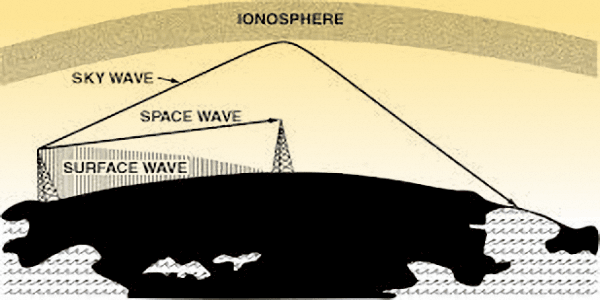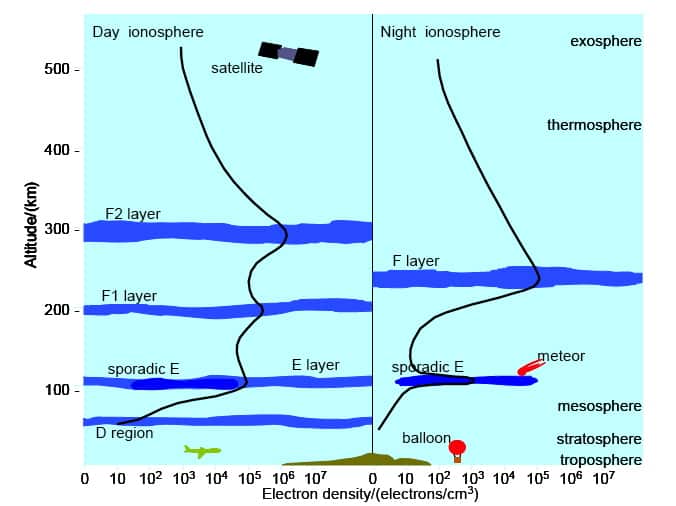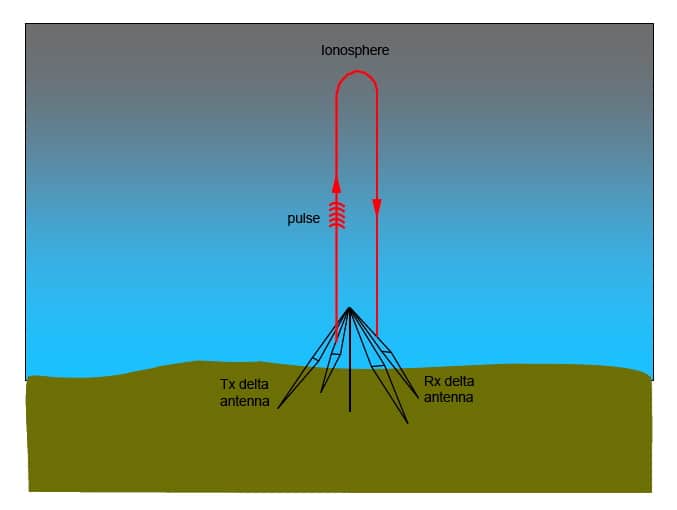Radio wave propagation largely depends on atmospheric conditions, the band and power used to operate the radio equipment.
Ground waves are “line of sight” communication. Atmospheric conditions come into play when transmitting between ham radio stations that are farther away and so, because of the curvature of the earth, cannot be reached through a straight line.
This is called a skywave. Since those atmospheric conditions are ever-changing, there are resources to allow operators to predict those conditions and the idea propagation techniques to use.
Various bands have different properties regarding those atmospheric conditions and can bound off the ionosphere or other particles to propagate further away.
More powerful stations are going to be able to reach further than weak stations, although some ham operators take it as a challenge to reach other stations with weaker power ratings (~5W instead of 100W to sometimes 1000W). This is called QRP.
Skywave propagation

The E and F layers contain a high density of ionized particles. DX (long distance) communications are possible when radio waves are reflected off the E and F layers in the ionosphere. This way radio waves can propagate all over the earth, bouncing up and down between the ground and the ionosphere. This is called a skywave. Note that during the day, energy from the sun splits the F layer into two distinct parts known as F1 and F2.
The F-layer (between 120km and 400km above the earth) contains the highest densities of ionized particles, is the most reflective of RF energy, and hence is responsible for most DX propagation of HF communications.
The E-layer can be found between 90km and 120km above the earth. The reflection of RF waves by this layer is responsible for most of the long-distance propagation valued by hams. The E layer both thins out at night and rises, again resulting in increased propagation distances. E layer propagation is most useful for frequencies below 10MHz.
Sporadic E-skip is caused by “clouds” of especially intense ionization. These are highly reflective and allow DX communication from 25MHz to 225MHZ. The clouds are usually relatively short-lived and occur mostly during the summer months.
The D layer can be found between 50km to 90km above Earth. Propagation by reflection from this layer is quite rare as it is highly absorbent of RF energy. The thickness of the D layer decreases during the night, allowing more RF to travel through to the E and F layers, hence propagation often improves during the night.
Day and night ionospheric conditions
The ionization of the atmosphere varies considerably between day and night. During the day:
- the D and E layers are continuous
- the F layer splits into F1 and F1 (F1 is lower than F2)
During the night:
- The F1 and F2 layers coalesce to form a single F layer that lies between the position of the daylight F1 and F2
- the D layer disappears altogether
- the E Layer is patchy
These ionospheric variations are responsible for the variations in propagation noticed across a 24 hour period.
How are ionospheric conditions measured?
Ionospheric conditions are measured using an ionosonde. This has two variants:
- a single high frequency radar that sends short pulses vertically upwards and records the time for the signals to be reflected back to the same place. Ionosondes are used to measure the height of the various ionized layers.
- pairs of transmitter and receiver that are a measured distance apart. These allow propagation between points to be measured
External links
- Propagation Resource Center
- D-Region Absorption Prediction Center
- Miles per watt/ km per watt calculator You will need to enter the grid squares of two stations and the tx power of the transmitting station.
- Radiowave Propagation Center
- Online VOACAP propagation tool



